Among seven officers on the firing line, one experienced a misfire. The first indication I had was a closeup view of his muzzle, which suddenly appeared two inches from the tip of my nose. At that time during the mid-1980s, standard operating procedure (SOP) for some agencies involved a cease-fire and raised hand whenever the shooter encountered a problem (nowadays we have ‘em deal with it and keep going). When his S&W Model 10 failed to fire, the shooter directly to my front instantly thrust both arms skyward and arced his gun-hand rearward.
by Steve Markwith, author of the Survival Guns series of books
I stepped sideways, grabbed the barrel, and twisted it back toward the target while calling for a cease-fire. The officer, although new to me, had retired from the military and then worked for other agencies. I’m not sure where he learned that particular trick but it was the last time he did it. Being a new firearms instructor at that time, it was highly educational though. One lesson learned was how quickly things can go wrong. Another was that some supposedly “firearms trained” individuals are not as safe as their background might indicate.
Boomerang Bullets
Actually, during the ensuing three-plus decades of range operations involving thousands of shooters, problems of this magnitude were rare. Thanks to the luxury of an agency-owned range, tight control of safety, construction, and upkeep was all possible. Still, unforeseen problems occasionally surfaced that provided opportunities for further enlightenment – occasionally with some excitement thrown in.
Frozen Backstops
Shortly after opening our outdoor facility, the big brass realized a few troops had missed their required re-qualification dates, but by that point it was February. Range conditions were typical for our northern climes: below freezing, lots of snow, and a granular coating of ice on the plowed range.
As soon as I issued a signal to fire, a barrage of bullets whizzed about in all directions. One smacked my vest amidships, another whined by my left ear, and several more wound up spinning like tops on the icy range. Fortunately, everyone immediately complied with the loud cease-fire command. More fortunately, no one else was hit.
The problem turned out to be the earthen backstop which had assumed the consistency of concrete. Earlier that winter the weather turned unusually warm and wet, saturating the berm. Then, our normal deep-freeze set in. Ideally, a range will face north for optimum lighting, but out of necessity, this one faced south. However, one “good” feature was its extremely high berm. As we discovered the hard way though (pun intended), during mid-winter, the sun’s angle was so low that the impact surface was always shaded. Nowadays, these conditions provide a great excuse to avoid freezing.
Lesson: Most folks probably shoot in more tolerable conditions, but don’t take a backstop for granted. Erosion can expose rocks or even accumulations of projectiles, increasing the odds ricochets.
Steel Target Terrors
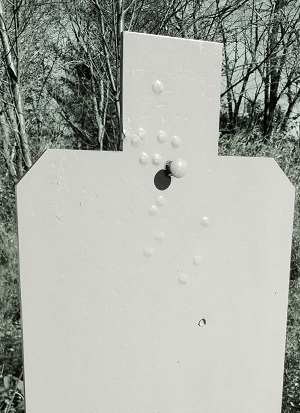
While attending a combat shoot on a commercial range, an energetic chunk of something glanced off my shoulder during a steel target stage. Meanwhile, another who was firing appeared to be in distress. Somehow, he had the presence of mind to re-holster his handgun before addressing the problem.
Turned out, a large piece of bullet had reversed course and drilled a deep hole in his shin, which was squirting out copious streams of blood. It’s still inside his leg, too.
The cause turned out to be an unnoticed deep crater in a shaded steel plate, the likely result of a 5.56 rifle impact. Among the ensuing volley of lead .38 Special rounds, one found its way into the crater, and with nowhere for the normal splatter to dissipate, it came back with a vengeance.
Good thing it didn’t hit his head or someone else’s (including mine)!
Lesson: Commercial steel targets are rated for calibers and safe stand-off distances, but smooth surfaces are also essential. Inspect them regularly for signs of damage, including dimples or bends. Check their supports as well.
Mean Bullets
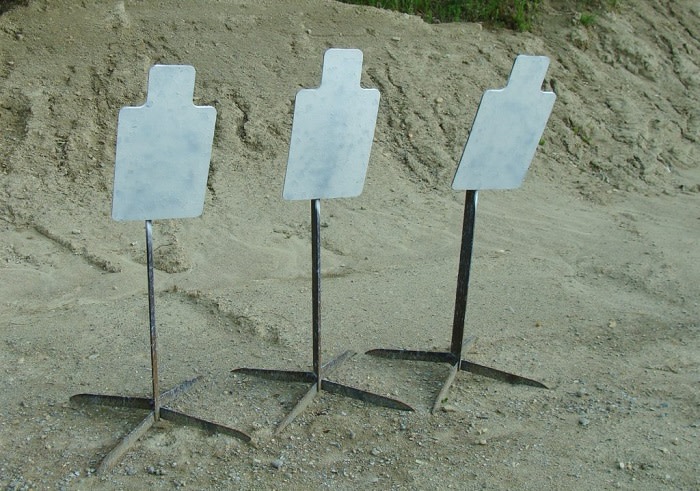
Many moons ago, while attending a prestigious out-of-state shooting school, handgun ammunition was provided for use on steel silhouette stages. The bullets, cutting edge at that time, were encased in a nylon coating. As we quickly found out, they also came back in clumps. Before long, one of the shooters was smote in his private parts, revealed to all by a shrill vocal reaction. We elected to let him perform his own exam which, fortunately, revealed no lasting harm. Afterwards, you couldn’t have paid the rest of us enough to shoot more of that stuff.
Lesson: Follow the manufacturer’s safety guidelines regarding steel target angles and projectiles. We still shoot lots of steel targets, but use is restricted to frangible (disintegrating) bullets.
Plastic Drum Tunes
The large, plastic 40–55 gallon barrels are sometimes used as cover props, a practice we discontinued as the result of an odd experience. During one drill stage, two drums were stacked up at 15 yards to partially obscure a combat target. The upper drum eventually received a near-glancing hit, whereupon the bullet entered it and began racing around its interior surface with a siren-like whine.
After numerous revolutions, it eventually ran out of steam and dropped to the bottom with a loud clunk. Shortly thereafter, a warning about the same situation was posted by a prominent firearms academy, the difference being one of their bullets exited through another hole and shot back. I’ve witnessed similar screaming bullet events at least two other times, so it’s probably not as rare as one might think.
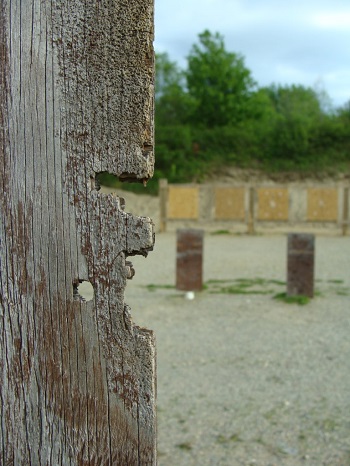
Range props like this barricade will take hits! 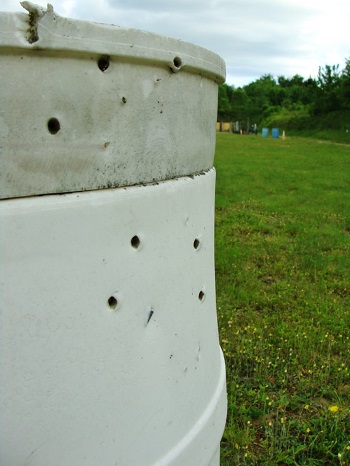
Some of the outboard hits lack corresponding exits.
Hopefully, the bullets remained inside.
Lesson: Cover-props or, for that matter, any downrange items will eventually be shot! As for the plastic drum, a wind-proofed cardboard panel would’ve worked equally well and been much safer.
Shot on a Firing Line
In his previous life, one of our top administrators saw lots of action kicking in doors amidst the rubble of Fallujah and other Sandbox hotspots. Upon retiring from the U.S. Army, he put his considerable credentials to further use by donning a blue uniform and badge.
Good thing he was wearing his vest the day he attended re-qualification, a precaution that allowed him to survive a direct hit from a .45 ACP round. One of the other shooters experienced a pistol problem and left the firing line with an instructor. While both attempted to fix it behind a storage shed, the pistol discharged, punched a hole clear through – and headed toward – the firing line. For the record, this incident involved another (previous) agency and a different range. Safe to say, our own safety protocols now receive lots of support from on-high!
Lesson: Ranges should incorporate designated safe-zones with bulletproof backstops. The above example illustrates why gun handling is prohibited behind many firing lines (including ours).
Other Misadventures
Some shooters revel in true creativity regarding operational techniques. They may also be skeptics of Murphy’s Law; namely, anything that can go wrong will go wrong – at the worst possible moment.
Inventive Safety Manipulations
During a defensive shotgun course, upon the signal to commence firing, a smoking crater appeared inches from a shooter’s toes. Like many other pump guns, the Remington Model 870 features a push-button safety located immediately behind the trigger. Ours were all right-handed, requiring a simple press of the trigger finger to disengage. Left-handed use was addressed through training.
The technique involved “giving it the finger” by reaching underneath the trigger guard. However, in an effort to shave some time, this left-hander curled his trigger finger directly through it. One thing’s for sure – he was fast!
Lesson: Short of actually firing, a finger inside a trigger guard introduces risks. For the record, I was trained on an M-14, which has an ambidextrous safety-lever inside its trigger guard. However, the clearance is generous and function is consistent. Among other types, function can vary. A M-870’s safety can be reversed for lefties (an issue solved by Mossberg’s tang-mounted design).
Creative Reloads
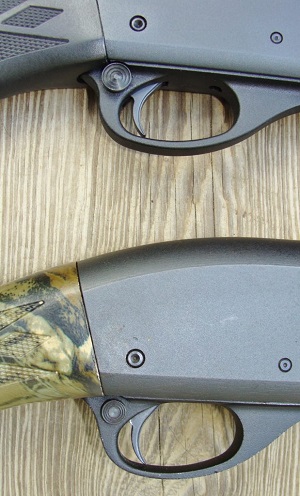
Among the firing line of ten trainees, one was experiencing an obvious reloading problem. Indeed, pounding a backward-facing magazine into a pistol will render it unusable. Fortunately, the pistol had gone to lock-back, meaning the chamber was empty.
Good thing it didn’t happen during a fight because it took disassembly and the efforts of two instructors to dislodge the magazine from the frame. Sure enough, despite instruction to the contrary, the two magazines in the shooter’s pouch had been inserted back-to-back for the sake of symmetry.
Lesson: Orient equipment (including magazines) consistently to support subconscious execution of critical tasks. Or, expect a visit from Mr. Murphy.
Departing Magazines
Some people eschew spare magazines, figuring one should cover most defensive civilian scenarios. But we’ve seen more than one fully loaded magazine launch down-range during a draw. Invariably it’ll be accompanied by a four-letter word. For this reason we test and procure holsters that effectively shield a pistol’s magazine release (while still affording access for deliberate removal).
Lesson: Prior to use of a holster for defense, perform enough gyrations to ensure everything stays put. Seat belts and arm rests are frequent causes of disengaged magazines. These concerns also apply to magazine pouches. Yes, you can drop a spare magazine in a pocket, but can you access it from various positions?
Blown-Up Guns
We experienced two ruptured chambers in one week using major-brand pistols and ammunition. Although the barrels and slides were wrecked, no one was seriously injured – and, luckily, both events occurred during training. Thorough investigations revealed none of the usual suspects: squib-loads, mixed-up calibers, bore obstructions, etc.
Eventually, we wound up with new guns and ammunition for no real out-of-pocket expense, although the actual causes were never fully established. A much more common source of dangerous uncontained pressure is a ruptured cartridge case – which leads to an important safety protocol…
Lesson: Hearing and eye protection should be part of every shooter’s range kit. We require both whenever firing is in progress. Other hazards include bullet fragments and uncontained gun parts that can launch during disassembly.
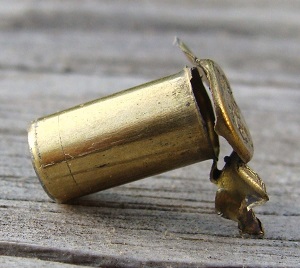
Wrong Ammo
Some people get in trouble by mixing up calibers, such as .380s chambered in 9mms, etc. I’m aware of at least one .40 S&W pistol that unraveled elsewhere during a multi-caliber pistol program.
One demonstration we perform involves slipping a live 9mm round into a disassembled .40 S&W barrel. Sometimes it’ll pass clean through, but sometimes it won’t! Either cartridge will feed from many magazines.
The frequently-taught tap-rack malfunction remedy could produce real drama if that happened during a live-fire scenario.
Lesson: We take care to isolate inventories of 9mm and .40 S&W ammunition, especially during instances where both are present on our range. This applies to other calibers as well. The 12 & 20 Ga. mix is a potentially lethal combination.
Shooting Range Mishaps and Lessons Learned Conclusion
Fortunately, injuries related to actual firearm discharges under our watch amounted to zero. Medical issues did sometimes arise, but most involved blisters, cuts, sunburns, or insect stings (life-threatening for some). A well-stocked first-aid kit was always on standby, but the items requiring frequent replacement were band-aids and tape.
But again, things can change within an instant. On a satellite range in use by affiliated staff, one shooter succumbed to a heart attack despite close proximity to well-staffed emergency services. For such reasons, we never conduct a live-fire without the means for emergency communication or ready access by ambulance. That’s worth considering when shooting on your own, too.
Today’s trauma kits are fairly affordable and could be worth their weight in gold if ever needed. Of course, avoiding sloppy gun handlers will go a long way toward keeping yours pristine.
What’s the wackiest things you’ve seen at a shooting range?
1 comment
I just want to say, thank you to all the firearm instructors out there. These add to some of the scary stories I’ve heard from firearm instructors. It’s great that we can learn from these lessons and be better. Has definitely taught me a few things about setting up my own personal range here on the ranch. Thanks!